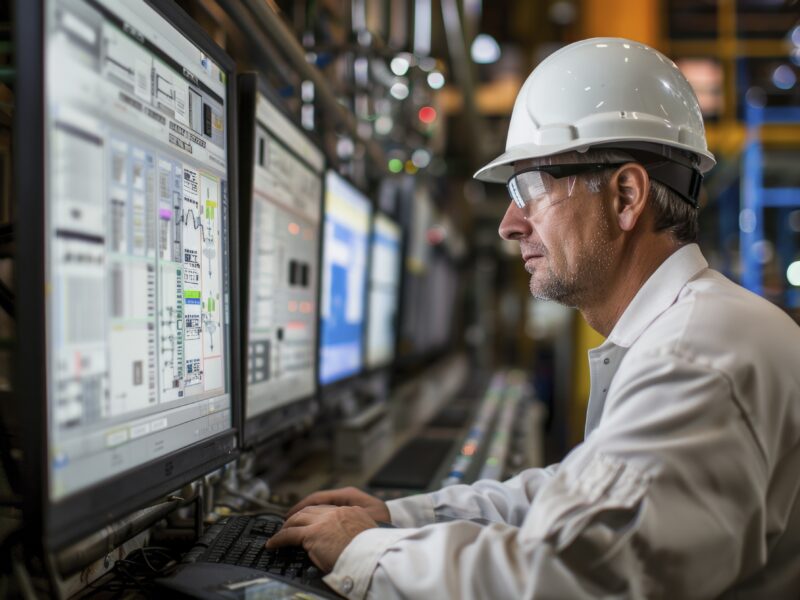
Speed, precision, and the ability to count on uninterrupted operations are the modern industrial characteristics, and these are the features made possible through Industrial Automation and Control. In the area of processing, the introduction of these systems has been credited with the increase in production, quality being leveled at all times, and even the saving of energy.The leader of this change is SR Automation, the number one for Industrial Automation and Control solutions in India. With a full range of several advanced products, SR Automation provides a pathway for industries to transform their older setups into smart, high-performance systems.
Key Products for Industrial Automation and Control from SR Automation
1. Programmable Logic Controllers (PLC)
A Programmable Logic Controller or PLC is an important device in Industrial Automation and Control systems. It is intended for controlling machines, production lines, and robotic applications with precision. The automation of the control to the extent of the PLC is the major objective; the replacement of manual control is thus done through a system that is faster, safer, and more consistent.
Uses:
- Activates and controls the operation of robots and assembly line machines
- Regulates the flow of liquids, drives, and airlocks in the manufacturing process
- Interprets information from various sensors to maintain stability and smooth operation
- Works with HMI, SCADA, and other automation systems
Benefits of PLC :
Fast response: Makes instant decisions based on input signals
Flexible: Easy to reprogram when production requirements change
Increases efficiency: Reduces mistakes and saves labor time
2. Human Machine Interface (HMI)
A Human Machine Interface, often called an HMI, is the window between people and machines. It comes in the form of panels or touchscreens that display live information from the production floor. Instead of operators guessing what’s going on, the HMI shows it clearly, making machines easier to control and processes easier to manage. In Industrial Automation and Control, the main role of an HMI is to give operators confidence and clarity when running equipment.
Uses:
- Displaying real-time production data in a simple format
- Allowing quick changes to machine settings with a touch of a button
- Alerting operators instantly when there’s a fault or alarm
- It Work together with PLCs, SCADA systems, and drives for smooth operation
Benefits of HMI
Easy to use: Operator-friendly screens and graphics are experienced and straightforward.
See what’s happening: The process can be monitored by the operators in real-time.
Fix problems quickly : By the time something that is wrong is discovered, the operator has already solved it before it escalates into a larger concern.
Works everywhere: Using HMIs made it easy for the operators to run machines at factories, pharmaceutical companies, and power stations.
3. Variable Frequency Drives (VFD)
Variable Frequency Drives (VFDs) are devices that facilitate the steering of electric motors in terms of speed and force. In the sector of Industrial Automation and Control, they are the reasons why machines are running more efficiently, consuming less power and, consequently, having a lower impact on their lifespan.
Uses:
- Change motor speed for pumps, fans, and conveyor systems
- Make motor start and stop smooth to prevent sudden jerks
- Work with automation systems for accurate control
Benefits of VFD :
Energy conservation: Motors consume only the power they require
Machinery protection: Gentle operation leads to less wear and tear
Control improvements: Workers can vary motor speeds for various operations
4. Servo Drives and Motors
Servo drives and motors help machines move with smoothness and accuracy, making operations more dependable. In Industrial Automation and Control, they’re used to manage precise motion and keep every process steady. This careful control improves product quality, reduces waste, and helps maintain consistent performance across production.
Uses:
- Control precise movements in robotics and CNC machinery
- Manage positioning and speed in packaging and assembly lines
- Integrate with automation systems for coordinated motion
Benefits:
Fast and accurate response: Motors move exactly as needed without delays
High precision: Maintains consistent quality in production
Improved efficiency: Smooth motion reduces errors and increases output
5. Sensors
Sensors are electronic devices that recognize alterations in the surrounding environment such as – distance, temperature, or pressure and transform these into signals suitable for computers. In the area of Industrial Automation and Control, sensors play a major role in making systems react automatically thereby improving safety, accuracy, and productivity as the main three benefits of such a systems approach.
Uses:
- Signal the presence of objects, the amount of or position in production lines
- Check the temperature, the pressure, or other vital parameters
- Set off automated actions in PLCs or other control systems
Benefits
Simultaneous detection: The quick response accelerates the process
Safer conditions: The possibility of mishaps or harm to the equipment is entirely removed.
Greater precision: The operation is regulated with utmost accuracy.
6. Servo System
The servo system is a complicated setup of the latest technology that integrates motors, drives, and controllers together for an exact motion control. It is precisely in the above-mentioned applications where the speed and accuracy are highly sought that Industrial Automation and Control use servo systems in robotics, CNC, and packaging systems.
Uses:
- Perform accurate motion in robotic arms.
- CNC machines control for detailed manufacturing.
- Supervise packaging or assembly operations.
Benefits:
High-speed response: Instantaneous and accurate motion control.
Exceptional precision: Output is always consistent at a high quality.
Downtime is reduced: Maintenance requirements are lowered due to smooth operation.
7. Compact Gear Motors
Compact gear motors consist of a motor and gearbox, giving them low power consumption with high torque giving a controlled torque in a small footprint. They are used in Industrial Automation and Control for example in conveyors, packaging lines, and small machinery requiring efficient motion control.
Uses:
- Drive small conveyors or material handling equipment
- Control rotational speed and torque in machines
- Integrate with automation systems for precise operation
Benefits:
Space-saving design: Can be set in hard places without giving up the power.
Reliable torque: Gives the same power all the time for precise operations.
Energy efficient: Cuts down the power usage that is not needed at all.
8. Spindle Motors
Spindle motors are primarily found in the rotation of the high-speed axis of CNC and similar machines like those used in woodcraft and furniture making. They supply accurate and repeatable motion throughout the entire cutting, shaping, or drilling process in industrial automation and control applications.
Uses:
- High-speed rotation for CNC machines
- Precision machining in manufacturing and woodworking
- Integration with automation systems for controlled operations
Benefits:
High precision: Guarantees the cuts and operations are perfect.
Smooth rotation: Keeps vibration down, which helps parts last longer.
Increased productivity: Machining is done faster and more consistently.
9. Woodcarving Machine Accessories
Accessories for woodcarving machines in general can be regarded as a ready-made tool that enhances not only the operating range but the precision as well. They create and control the smoothness and accuracy of carving with Industrial Automation and Control practices.
Uses:
- Support cutting, engraving, and shaping operations
- Improve precision in woodworking
- Work with automated control systems for complex designs
Benefits:
Enhanced accuracy: Produces detailed carvings consistently
Better efficiency: Saves time in production
Reduced errors: Minimizes mistakes during carving
10. AC Drive
AC drives are the devices that manage the rotation speed and power output of the AC motors. In Industrial Automation and Control, they are the means of maximizing motor efficiency as well as minimizing energy use.
Uses:
- Control motor speed in pumps, fans, and conveyors
- Reduce energy consumption in industrial systems
- Compatible with PLCs and automation controllers
Benefits:
Energy efficiency: The motor runs only when it’s actually needed
Smooth operation: Helps avoid sudden stops or sharp starts
Improved control: Lets you adjust the speed for each process
11. Stepper Drive Motor
Stepper drive motors are the types of motors that provide an exact step-by-step movement for automation applications. They are very much suited for positioning tasks that require accurate repeatability in industrial robotics and control.
Uses:
- Accurate positioning in assembly lines or CNC machines
- Control movement in packaging or printing machinery
- Incorporate with automation systems for operations that need to be repeated
Benefits:
Precise control: Moves in breaks of 1 step and thus has maximum accuracy
Continuous performance: Grants the same results every time
Simple integration: Perfect match with PLCs and other devices
12. Stepper and Servo Gear Box
Stepper and servo gearboxes provide motion transmission while they control speed and torque at the same time. Smooth and accurate mechanical movement is ensured in Industrial Automation and Control by these gear boxes.
Uses:
- Reduce motor speed without decreasing torque
- Make simultaneous movements in multi-axis machines
- Automation through connecting with stepper and servo motors
Benefits:
Torque control: Quiet and smooth running of machines
Precision: Good for accurate positioning
Efficiency: Less mechanical wear and tear
13. Injection Molding Machine Controller
These controllers take charge of injection molding machines for accurate, repeatable production. The injection molding machine controller’s role in Industrial Automation and Control is quality assurance throughout the plastics sector.
Uses:
- Regulate temperature, pressure, and timing in molding
- Cycle production automatically
- Connect with sensors and HMIs for watching
Benefits:
Quality: Consistent production
Productivity: Less time for production
Mistakes: Control by automation leads to fewer errors
14. SMPS (Switch Mode Power Supply)
SMPS gives industrial systems power that is stable and efficient. In Industrial Automation and Control, the reliable power makes the operation of all automation devices smooth.
Uses:
- Supply consistent voltage to PLCs, HMIs, and drives
- Protect sensitive electronics from power fluctuations
- Support continuous industrial operations
Benefits:
Stable power: Prevents downtime due to voltage drops
Energy efficient: Reduces electricity consumption
Protects equipment: Safeguards electronics from damage
15. IPC & SCADA System
Industrial PCs (IPC) and SCADA systems provide centralized monitoring and control. In Industrial Automation and Control, they allow operators to oversee the entire plant efficiently.
Uses:
- Monitor production lines in real-time
- Collect and analyze data for process optimization
- Integrate with PLCs, HMIs, and drives
Benefits:
Real-time monitoring: Operators see everything at a glance
Better decision-making: Data helps improve efficiency
Centralized control: Simplifies management of complex systems
16. Temperature Controller
The temperature regulators in the industrial processes are the main control elements for receiving and rejecting heat. In Industrial Automation and Control, they provide the required thermal accuracy for continuous production with little variation.
Uses:
Maintain temperature in the ovens, furnaces, or reactors
Establish and keep the ideal conditions for the processes
Continuous control of the process through connection to the automation systems
Benefits:
Temperature control: Ensures product quality
Energy saving: No risk of excessive heating or cooling
Stable process: Failures in the process will be less frequent
17. Encoders
The gap that encoders fill is providing the most precise feedback possible regarding the position, speed, and direction of the motors or machines. In Industrial Automation and Control, they guarantee precise movement, synchronization and thus process reliability.
Uses:
- Detect the position and rotation of the motors or shafts
- Relay the information to PLCs and drives for accurate control
- Facilitate robotics, CNC, and assembly lines with their accuracy of movement
Benefits:
Very accurate: Machines will be moving in the exact way the operator wanted
Control of the process improved: The operator will be able to produce the same quality consistently
Reduction of errors: Avoiding misalignment and machine faults
Upgrade Your Factory with Smart Automation Solutions
SR Automation helps turn your factory into a smarter and more efficient facility, ready to meet future demands, with advanced industrial automation and control solutions.
Explore the full product range here: SR Automation Products
Get in touch: Contact SR AutomationSR Automation — Empowering Industries with Intelligent Automation.
